Marvelmind Indoor Navigation System
In this tutorial, we will show you how to connect Marvelmind Indoor GPS system with Leo Rover.
Marvelmind Indoor Navigation System is an off-the-shelf indoor navigation system, designed to provide precise (±2cm) location data to autonomous robots, vehicles (AGV), and copters. It can also be used to track moving objects via mobile beacons attached to them. Other applications include, for example, forklifts, virtual reality (VR) systems, helmets for construction workers or miners, etc.
For the purpose of this tutorial, we have prepared leo_marvelmind package
which makes use of Marvelmind ROS packages to provide the rover's estimated
position, from the Marvelmind system. You won't have to write a single line of
code, but some configuration may need to be tweaked to work best in your
environment.
Make sure you are operating on the newest image for the Raspberry Pi and you are up-to-date with the packages and have the newest firmware flashed.
You will also need to have ROS installed on your computer and some previous experience with ROS is also recommended.
This tutorial was done on linux. If you are using windows, you might need to download and install STM32 Drivers and (optionally) DfuSe (DFU programmer). Both can be found on Marvelmind page.
Prerequisites
List of components
In this tutorial, we integrate Marvelmind Starter Set Super-MP-3D consisting of:
- 4 stationary Super-Beacons
- 1 mobile Super-Beacon
- 1 Modem v5.1 supporting up to 250 beacons
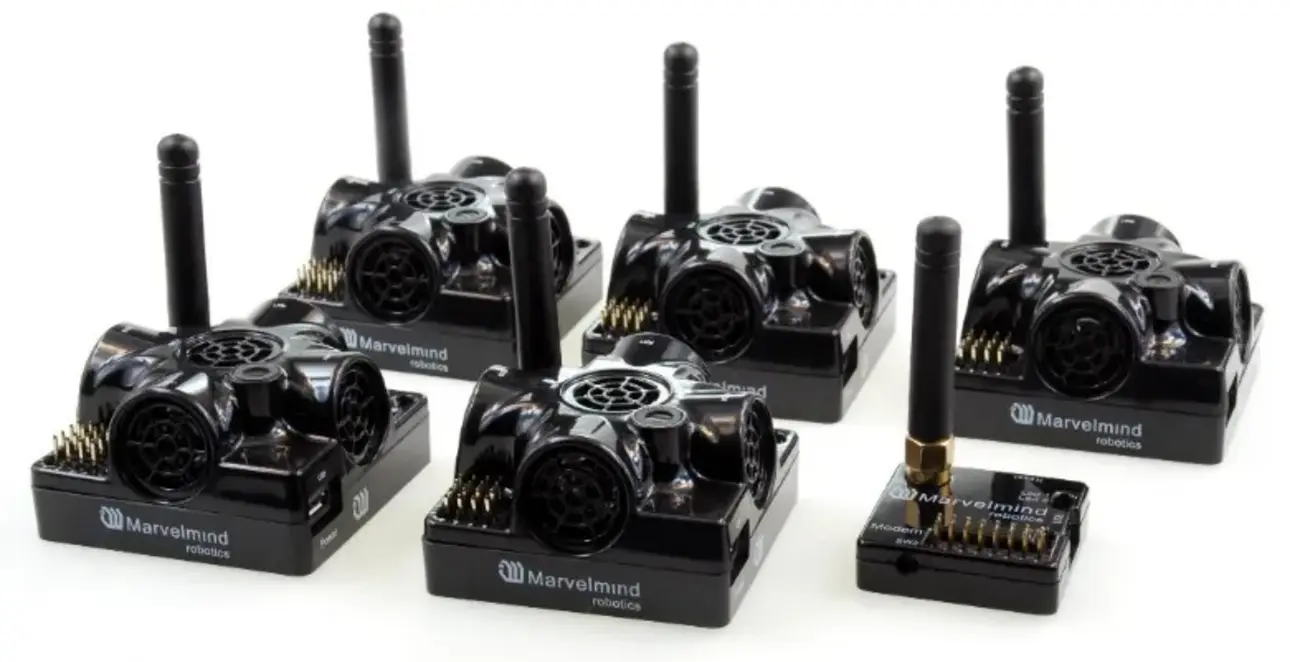
Marvelmind provides a few architectures for their system. This tutorial is
configured for Inverse Architecture (IA):
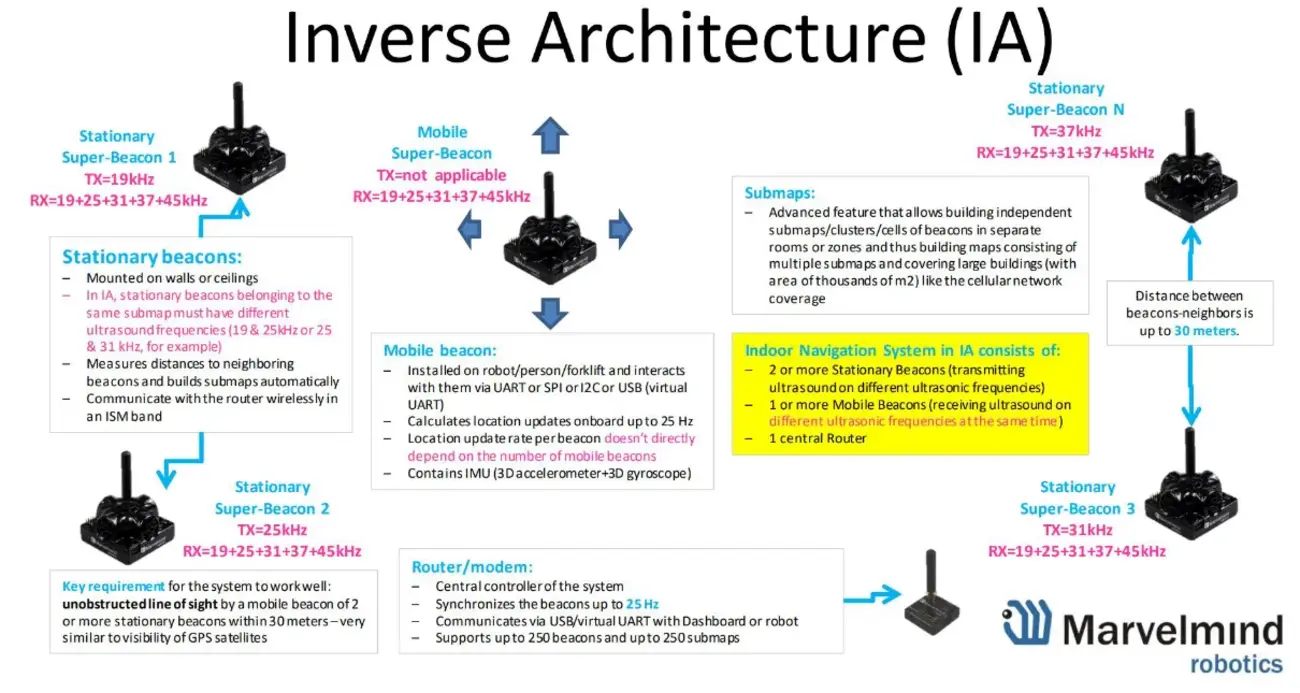
Here is a quick comparison of the architectures:
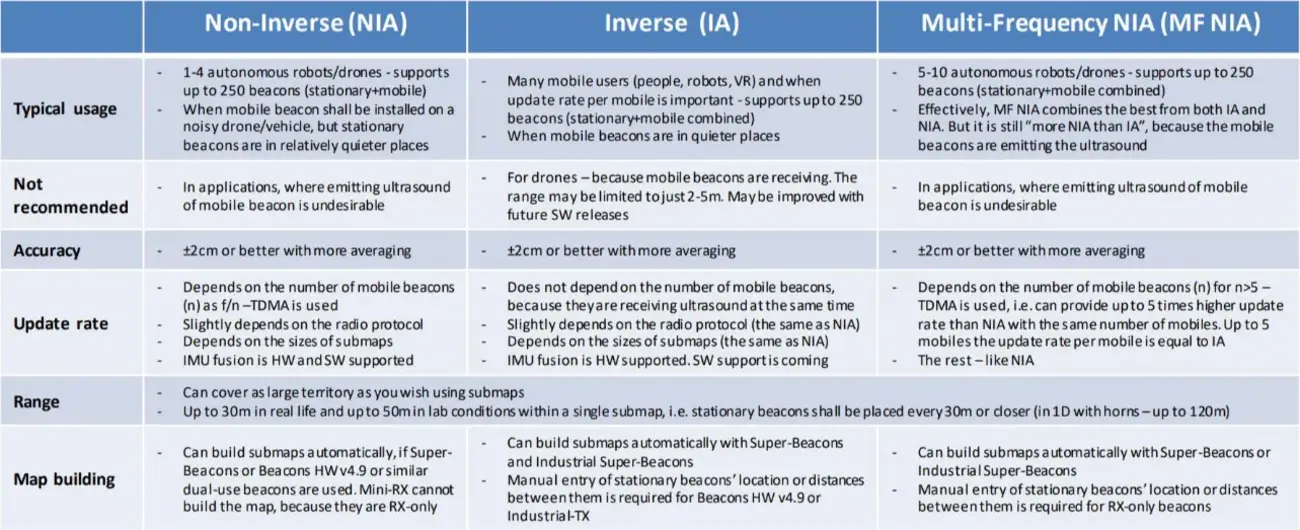
You can find some more information in this and FAQ section on the Marvelmind page.
Inverse architecture requires stationary beacons to have different frequencies.
Software integration
Downloading Marvelmind software and API
In order to use Marvelmind system for navigation, you need Marvelmind API and their software. In the software, you can find the newest firmware for the beacons and modem, and API is needed to upload it to the device.
To download the required files, you can go to Marvelmind page with downloads, and find the newest package, or download it from here.
Once you have downloaded the package, you need to unzip it. On Linux, it can be
done with the unzip command line tool. In terminal, just go to the directory
where the zip file has been downloaded (default is ~/Downloads) and type:
unzip marvelmind_SW.zip
Then, in the extracted directory, go to Dashboard/linux. The next directory
you need to choose based on your computer's architecture (for us it was x86).
In the Dashboard/linux directory, there is a PDF file with instructions for
the linux versions of dashboard. It's worth to do the things described there.
You can check what your architecture is with:
uname -m
or:
dpkg --print-architecture
Then, go to the specified directory, and give execution rights to
dashboard_<computer architecture> file:
chmod +x dashboard_x86
Updating firmware on beacons and modem
For each beacon you will need to do the same things. There is only one additional step for the mobile beacon, but it will be mentioned later.
Beacon configuration requires it to be connected to the computer, so it might be faster for you to complete upgrading and configuring beacon and then switching to the next beacon, than switching beacons after firmware update, and then connecting them once again, for configuration.
First, charge all the beacons with a USB cable (full charging takes 2-4 hours).
Run the dashboard by typing in the correct directory:
./dashboard_<computers architecture>
You should see something like this:

Now, you need to turn on your beacons (or just the currently upgraded ones not to waste the battery in other beacons) by placing the DIP switches like it is shown below:

Now, connect the beacon to the computer with the USB cable. Once it is found, your screen should change to something like this:
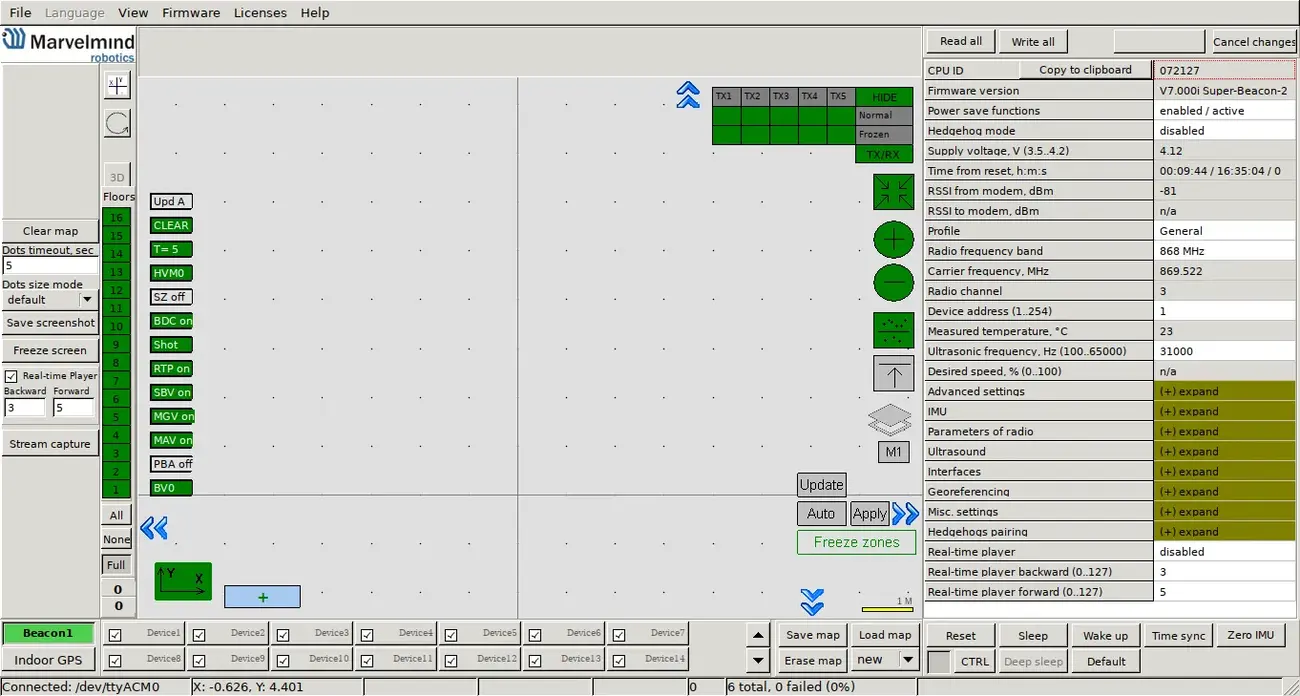
If you have problems with connecting beacons to the computer, there are some solutions:
- Check with
dmesg -wif your computer detects connection of usb device (run it before connecting beacon to computer), - If you see the message “Not found modem connection to computer through USB” it usually means that you don't have STM32 drivers installed. To install the driver, down load it with link at top window in the Dashboard and run the installation file, then click on the link under and install the driver.
If your beacon is connected, go to Firmware -> Upload firmware. You should see a new window.
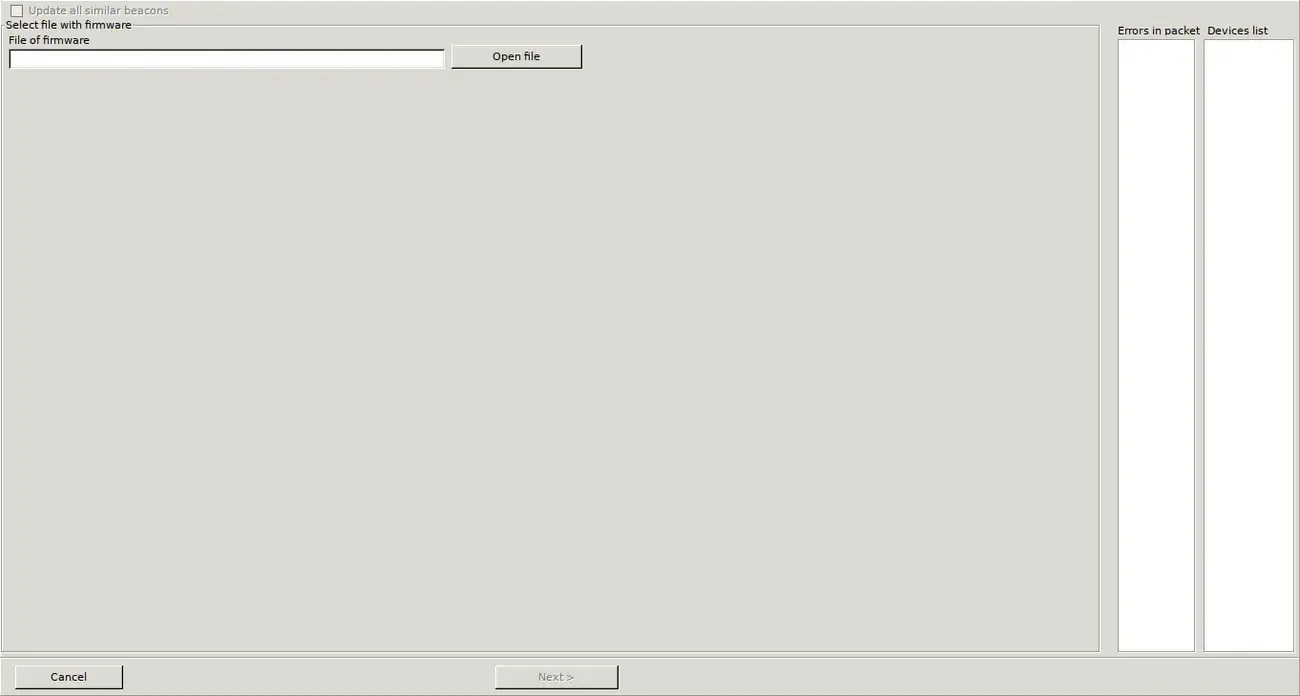
Click Open file and choose the correct firmware file. As we are integrating
for Inverse Architecture, choose from the base directory of unzipped package
Software_ia. Then, choose super_beacon_ia (if you have some other type
of beacon, choose the directory for your device). From there, choose the .hex
file (there should be only one in the directory) and click Open. Then, click
the Next button in the bottom part of the window, and the firmware upload
will start.
For modem, the only difference is that from Software_ia directory you need to
choose modem_hw51_ia or modem_hw49_ia directory, depending on the type of
the modem you have.
When the update is complete, you will see something like this:
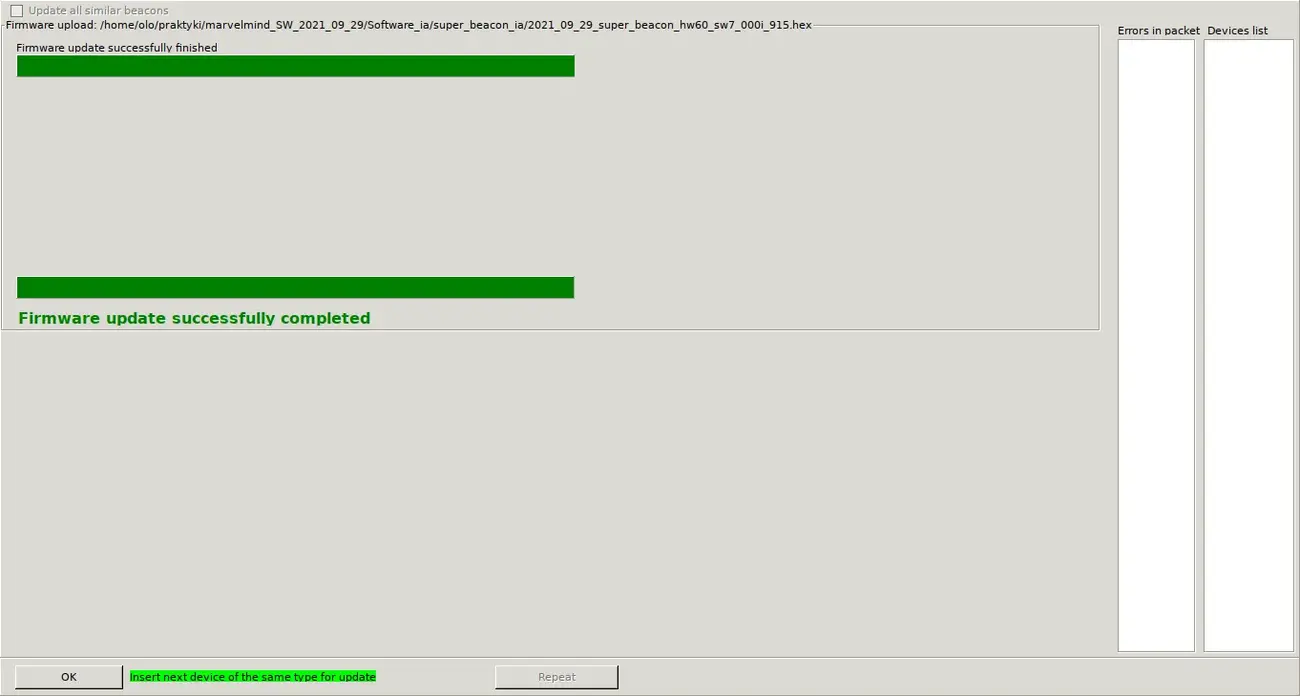
Make sure that you upload right firmware (beacon's SW to beacons and modem's SW to modem) and that you chose right version of the device (if you have doubts, you can check it on the sticker that's on the bottom part of the device).
If you have any problems with HEX programming, use DFU. Full instruction can be found here on page 109.
Configuring Beacons
While the beacon is connected, click Default in the dashboard to upload the default settings (the beacon will reconnect to the dashboard).
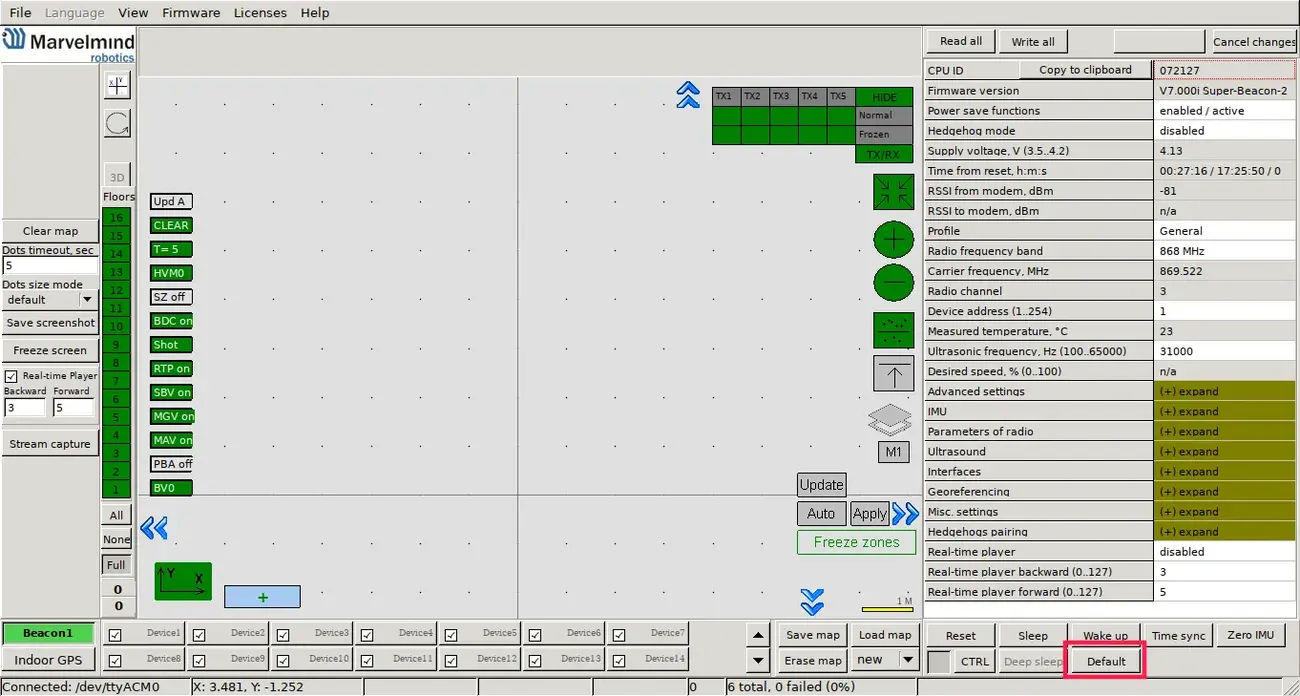
Change the Device address at your convenience (it's important, as we will wake the beacons based on their IDs).
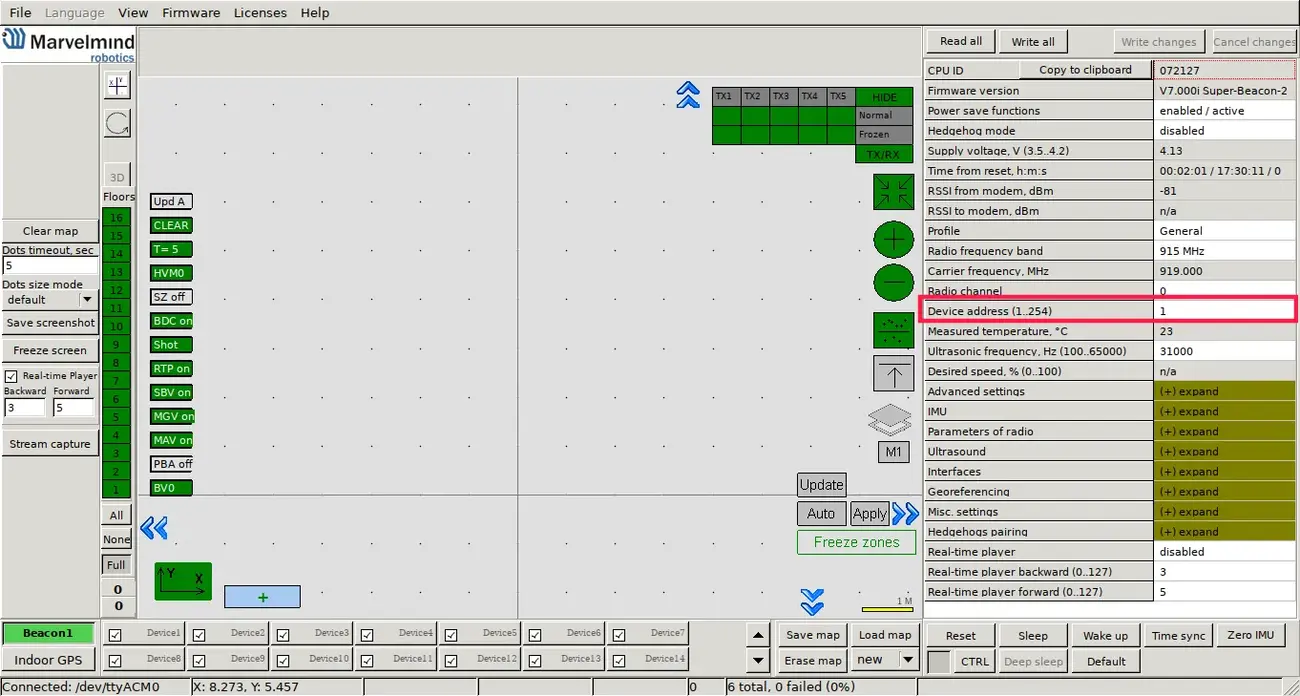
Change the Ultrasonic frequency to the frequency given on the sticker on the bottom side of the device.
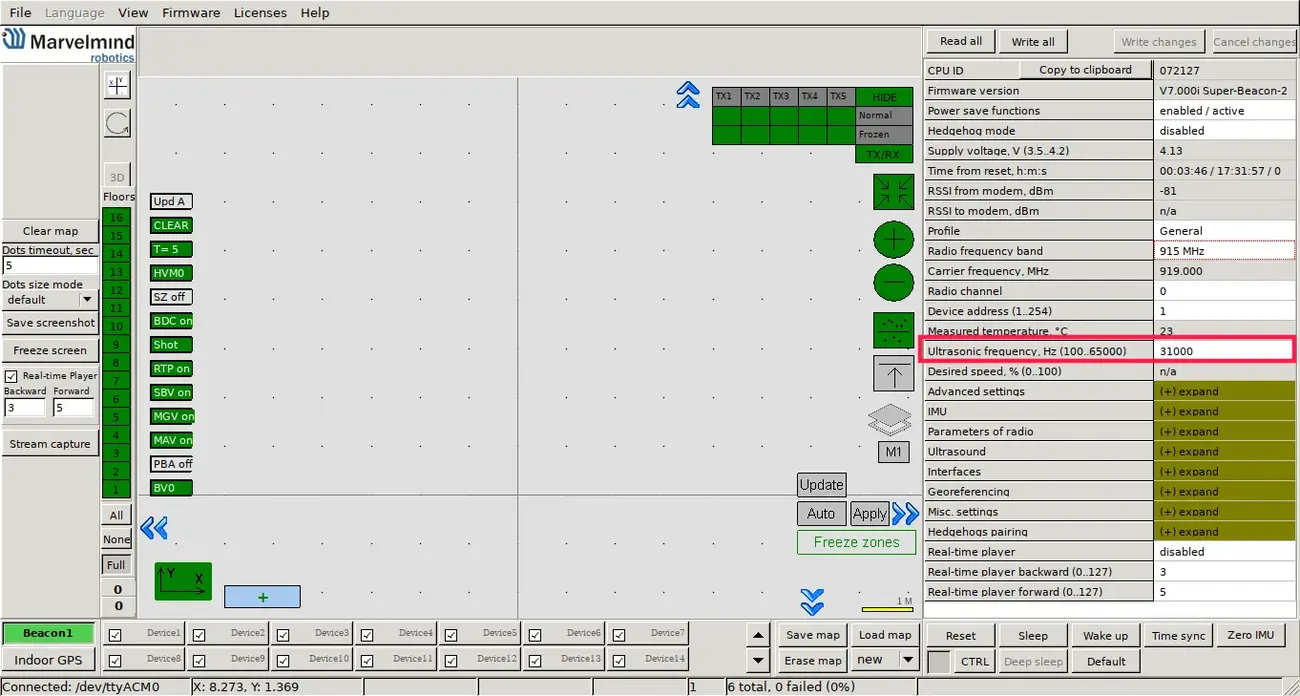
You can also change the Radio frequency band to some value that is legal in your country.

Only for the mobile beacon: change the Hedgehog mode to enabled.
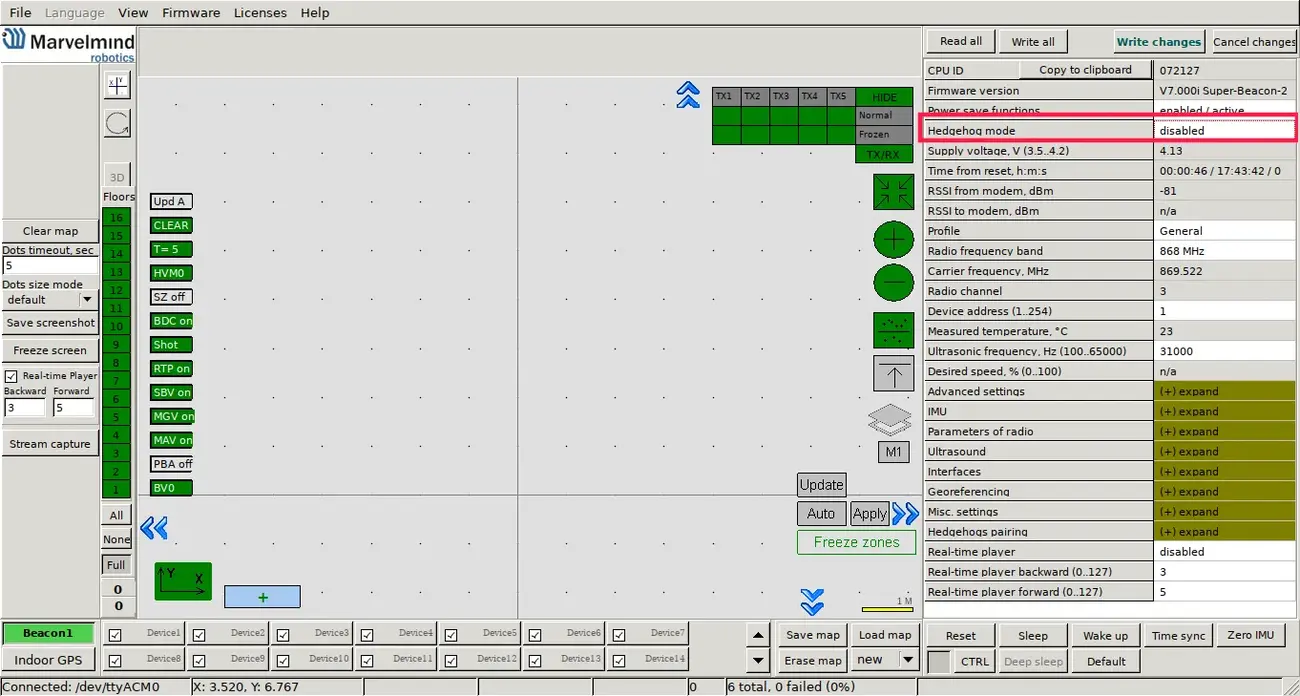
Choose IMU mode Normal from IMU section.

Only for the mobile beacon: in Interfaces section enable Processed IMU data and Raw internal sensors data.
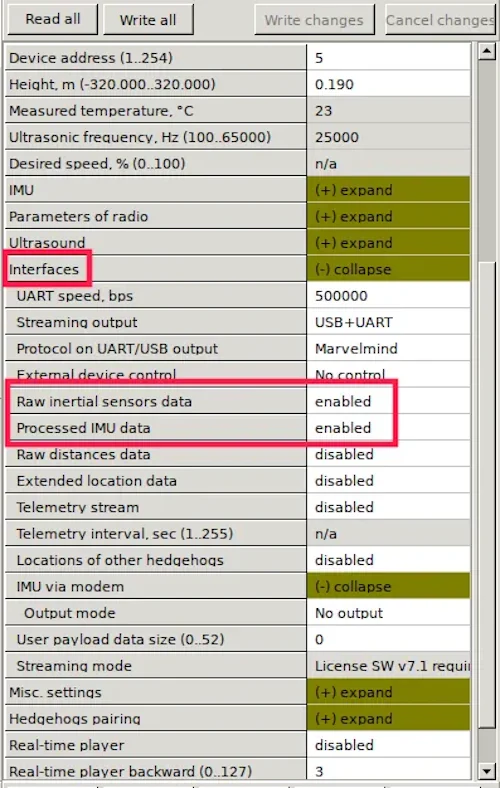
Don't worry if during configuration device reconnects to the computer, it sometimes happens.
To save changes, press Write changes in the upper right part of the dashboard, and reset the device (the button above the DIP switches for beacon; the button on the side - for modem).
Mounting Beacons to the walls
With each beacon, there is a velcro in the box. You need to attach one part to the beacon, and the other to the wall.
Place the stationary beacons high on the walls vertically in a way that will provide optimal ultrasonic coverage (make sure that the antenna is in the upper right corner of the beacons).
Measure the height at which the beacons are placed, as we will need it for future change in settings.
Here is a video with additional instructions on installing the beacons on the walls.
Possible setup:
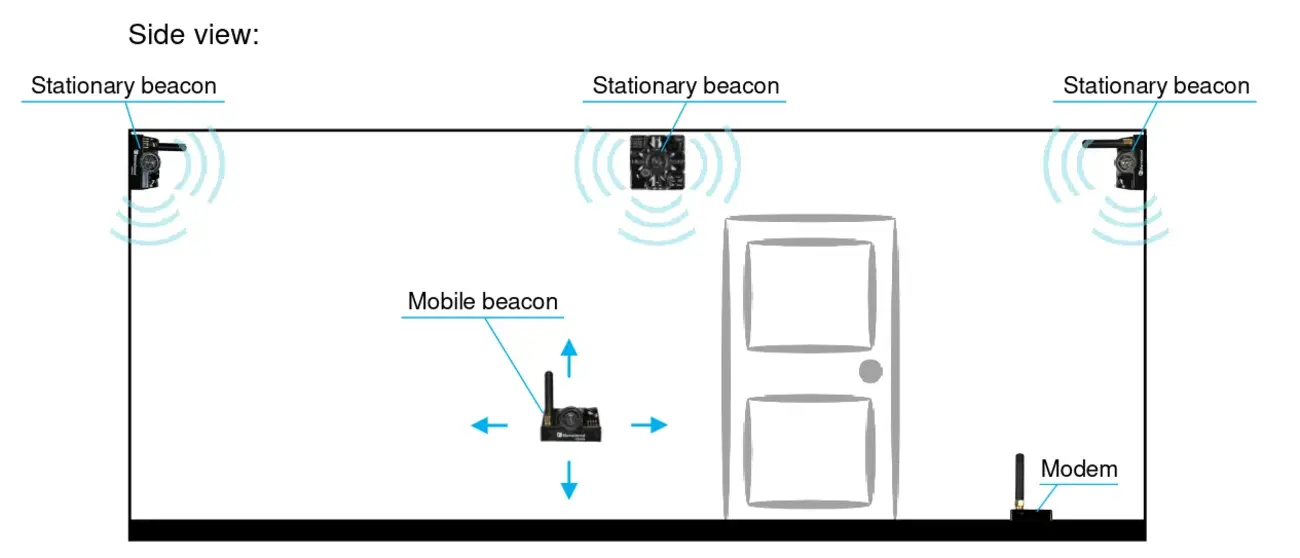
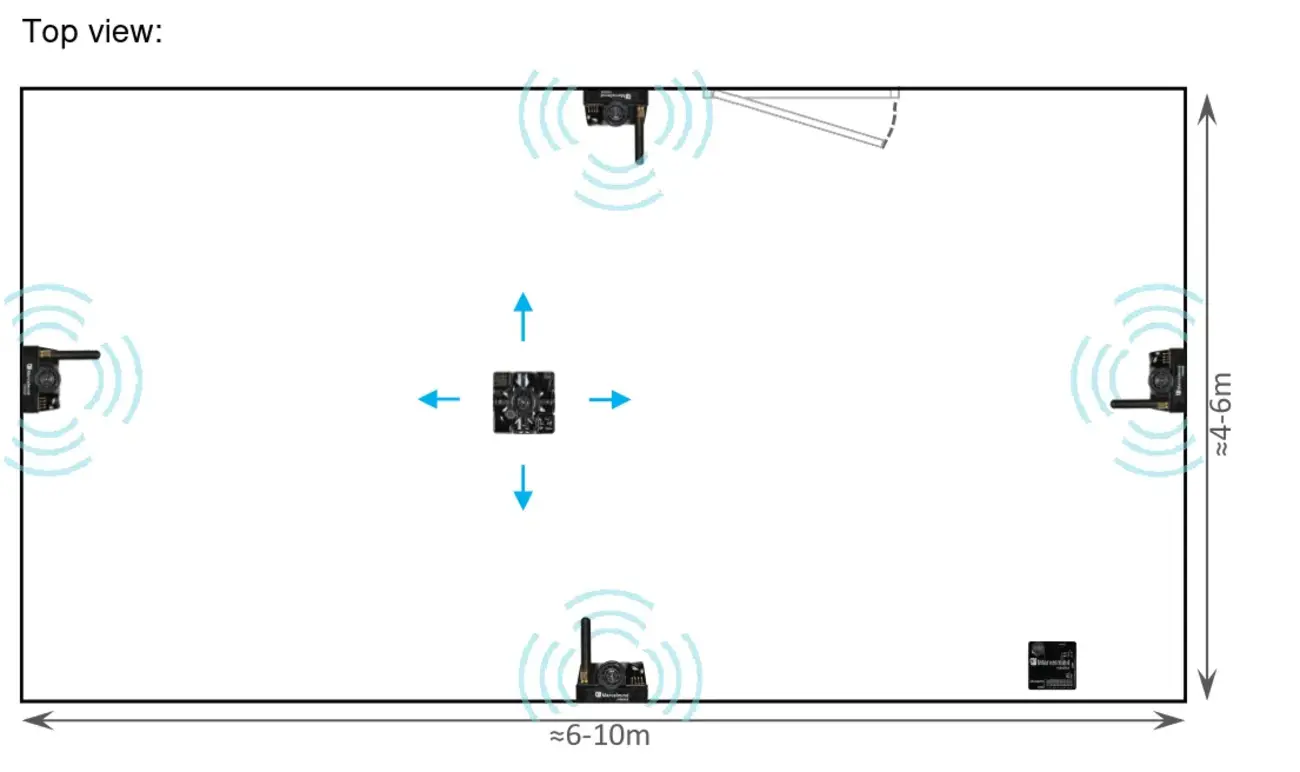
Make sure that beacons can "see" each other. If there is something in the way, the system might have problems with measuring distance between beacons.
Setting Map
If you have turned off the dashboard, turn it on and connect the modem to your computer. Turn on all the stationary beacons. Now, you need to wake them up. In the dashboard, with the connected modem (in the lower left corner, the modem should be shown as connected), in the lower part of the dashboard, there are numbers of devices. Double click on a number to wake up a device with a given number.
It might take 7-10 seconds for the beacons to wake up.
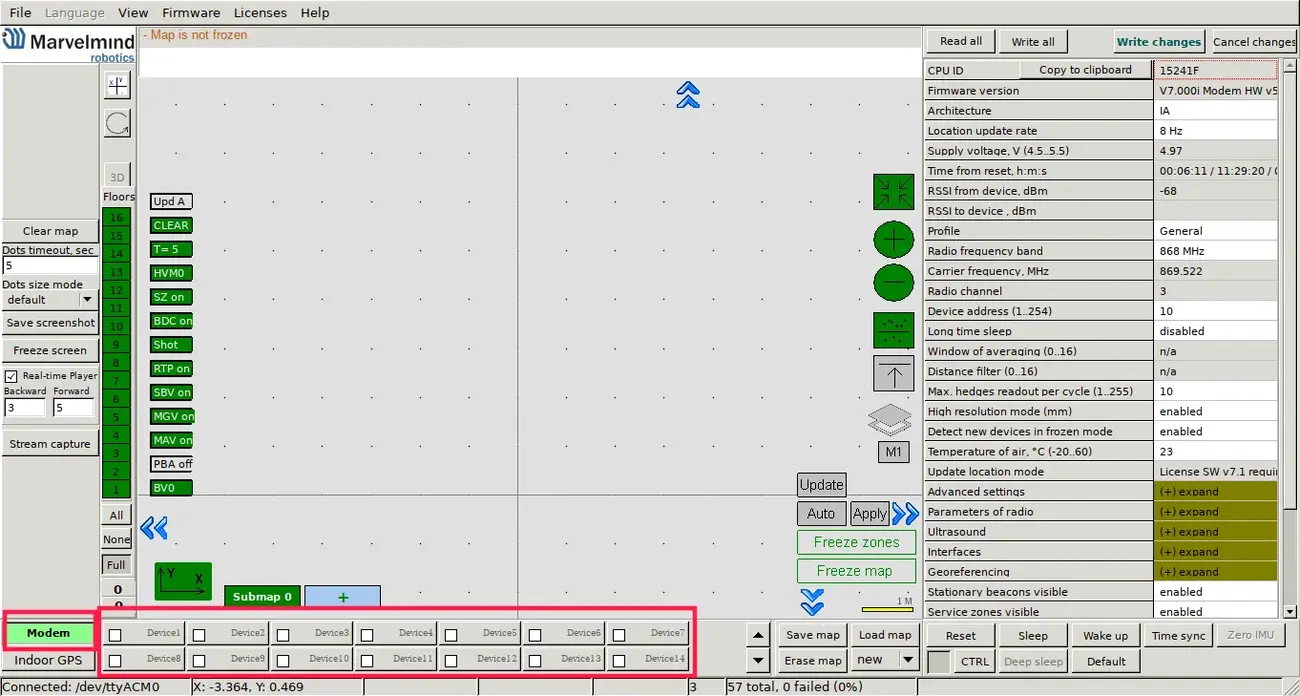
Now, when the beacons are turned on, the system may run the frequency search if it is the very first time you are waking up the beacons.
If this step does not work, disconnect the modem and connect that beacon again via USB. Press the DEFAULT button in the Dashboard and the Read All button to make sure that the radio settings are the default ones.
Also check that the radio settings on the modem and the radio settings on the beacon are the same.
Now, by clicking on the woken device, you can see and change its options (you can check RSSI, voltage, ultrasonic filter settings, etc.) on the panel in the right part of the Dashboard.
Double click on the device to both put it into sleep mode and to wake it up.
If the modem is not active and is not powered, the beacons will go into sleep mode automatically after 1 minute
For each beacon you have turned on, enter the height it's placed at.
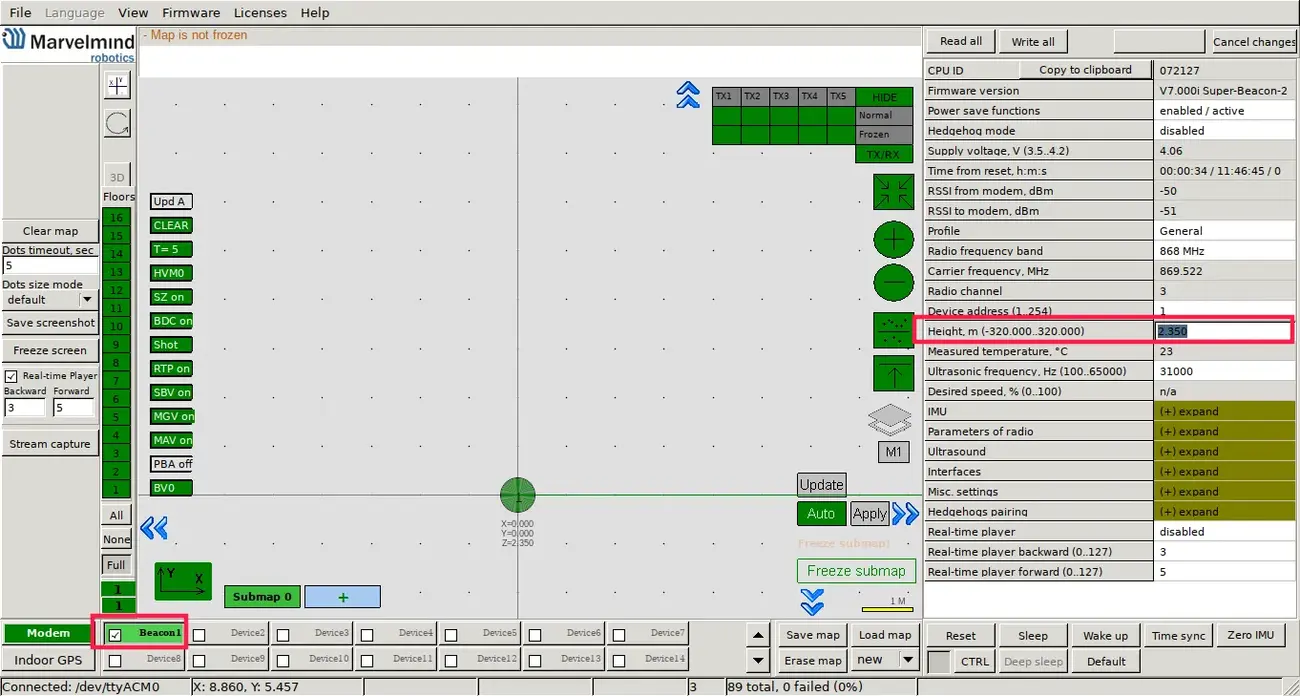
At this moment, the map should zoom in and form automatically. If the map didn't form well, check the table of distances in the upper left corner.
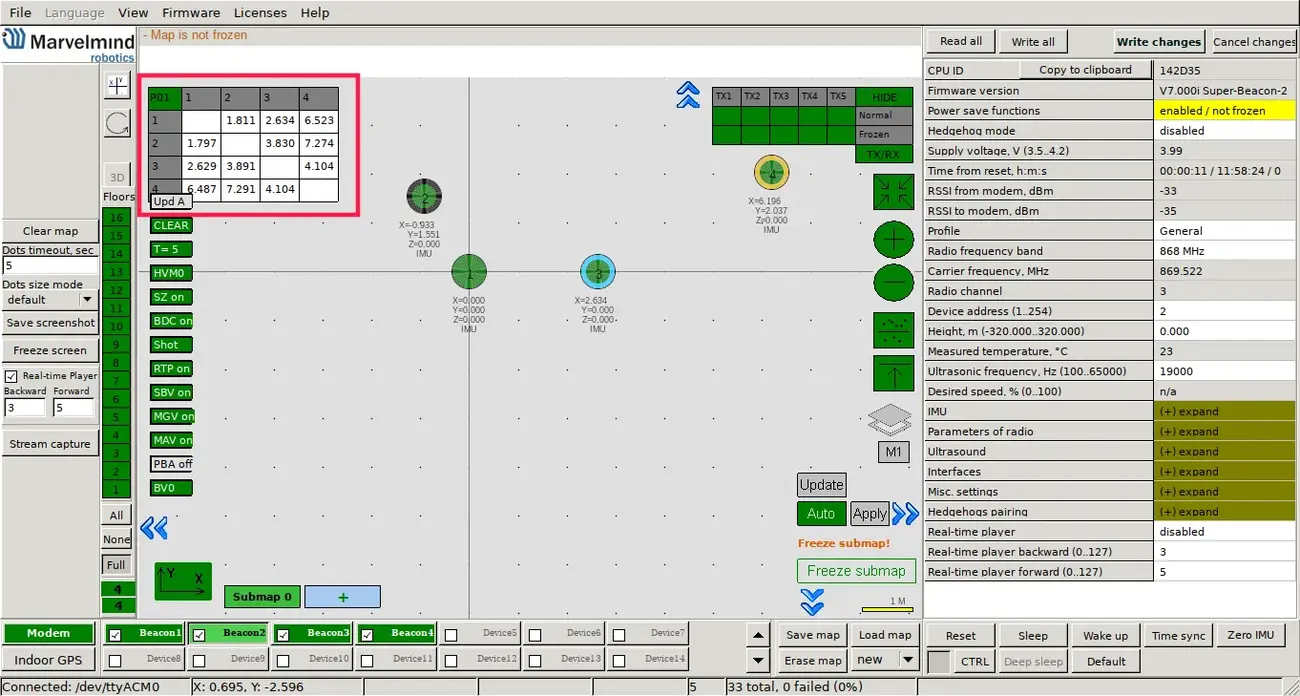
Only 4 stationary beacons may be in 1 submap. If you wake up more beacons, create new submap for them. Or it won't be displayed on the map and in the table of distances.
Next, you need to make the service zone. To do so, just press Shift+Left mouse button on the map to add a point (press the same combination on a point to remove it). Two points will form a line; three and more - a polygon. In the end, you should have something like this:
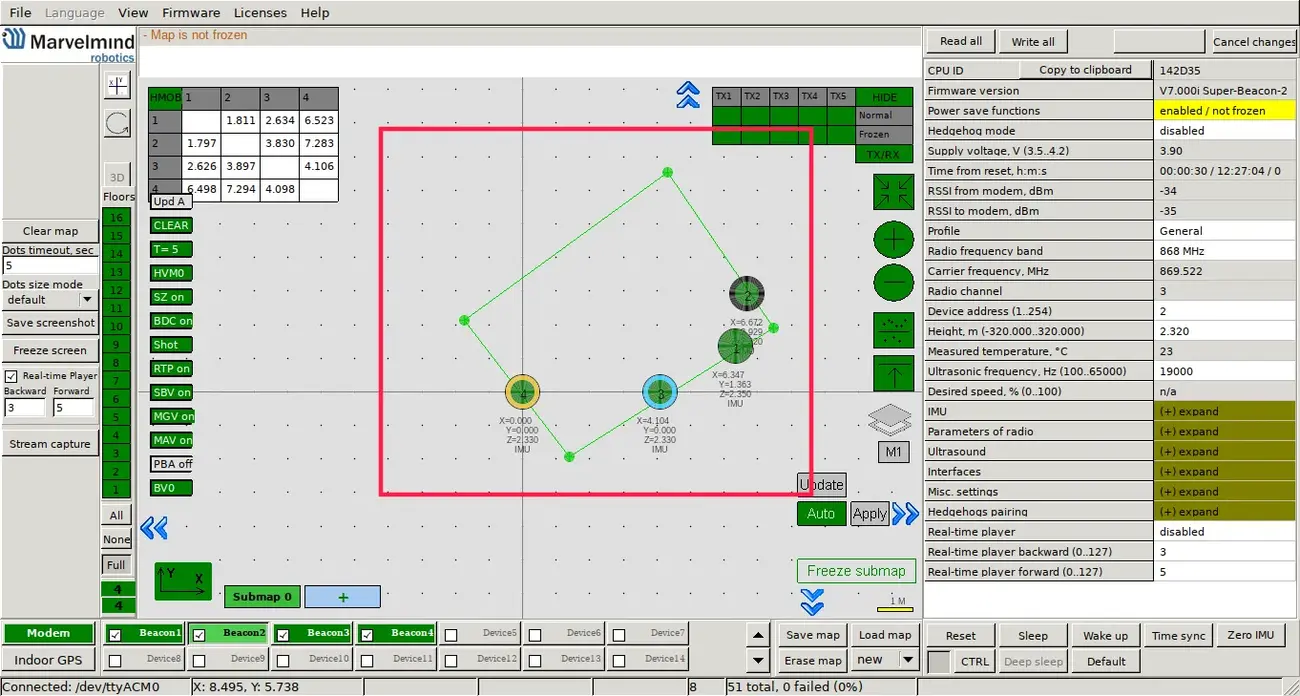
The last step is to freeze the submap and the map (provided that everything in the previous steps was good). When you freeze the map, stationary beacons will stop measuring relative distances and will be ready to measure distance from the mobile beacon.
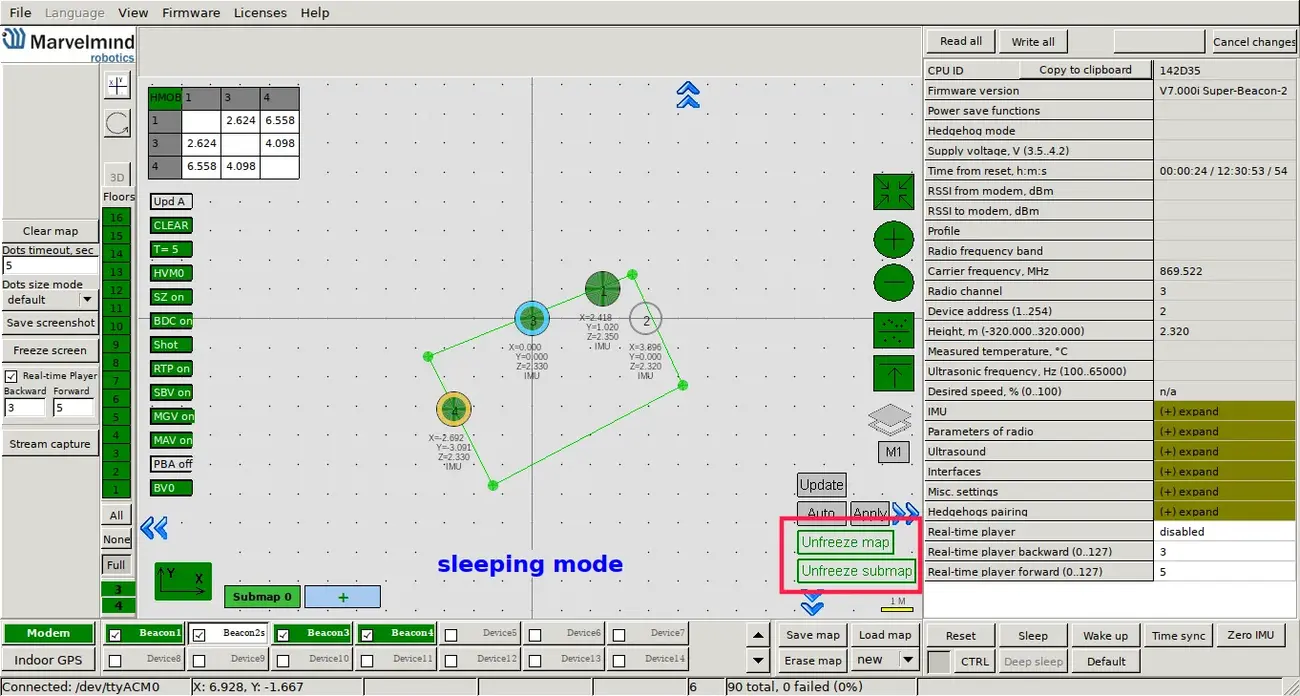
Solving problems with table of distances
If in the table you see some empty cells (except for the cells on diagonal) or marked yellow/red, it is an indication that distances between some beacons are measured inconsistently or are not measured at all. Try re-positioning them because usually there is an obstruction of some sort between the beacons.
You can also input the distance between beacons manually. To do so, just right-click on a cell that corresponds to a given pair of beacons, then, choose Enter distance for pair. After that, you can also freeze the distance for that pair (or you can later freeze the whole submap at once).

Here are the meanings of possible cell colors:
- white - everything is good, you can freeze the map
- yellow - something seems to be wrong, check distances and sensors before freezing
- red - some critical misses, do not freeze the map; manually measure and input distance, or reposition the beacon
- green - frozen distance, you can freeze the map, but be careful with values
It's also worth considering the diagnostic messages in the upper part of the Dashboard. There, you can find important system's messages which may contain a lot of useful information (for example, a message about repeating beacon frequency when you have IA).

Starting measurement
As you could mount beacons to the walls, you can also mount the mobile beacon on the rover using velcro.
For the beacon to have the same rotation axes as the rover, you need to mount it in such way, that the beacon antenna is in the upper right corner, when looking from above the rover (in z axis).
You also need to connect the mobile beacon to the rover, with a micro-usb cable (connect the cable to the slot, of the beacon, which you used to charge the beacons), to the usb socket on the rover's mounting plate (you may need some adapters to do so).
When you have the map, and mobile beacon is mounted on the rover, you can turn it on following the steps for stationary beacons (turn on the power of the beacon, wake it up in the dashboard, input height). After you have done those steps, mobile beacon should be traceable in 5-7 seconds. The system is now fully operational.
It's possible, that after waking the mobile beacon, you will have to unfreeze the map, and freeze it again. Doing this, will allow the system to add the mobile beacon to the map. Follow the diagnostic messages in case of a problem.
Examples
Marvelmind navigation with ROS
Right now, the only way we see the estimated position of the rover is in the dashboard. But it would be more useful to integrate the Marvelmind navigation system with ROS, as it will allow us to do anything with the position (for example, navigating the rover).
To do so, we utilize leo_marvelmind package which provides:
- marvelmind
hedge_rcv_binnode which is able to communicate with mobile beacon or modem and provide received location and other data - nodes for parsing messages from Marvelmind topics to ROS msgs
- robot localization nodes to have estimation of the rover position using rover data and Marvelmind data
Installing packages:
First you need to download our leo_marvelmind package, from github repository.
To do so, connect to the rover via ssh. Once you are connected, you need to
download the package in your ros workspace, in the src directory. If it's in
your home directory, type:
cd ~/ros_ws/src
git clone https://github.com/LeoRover/leo_marvelmind_tutorial.git
Now we need to install all required rosdep dependencies:
cd ~/ros_ws
source devel/setup.bash
rosdep install --from-paths src -i
And in the end, if everything installed successfully, you have to build the package:
catkin build
Adding mobile beacon to URDF model
The rover should be aware of where the beacon is located, and what space it occupies. You can ensure it does that by making URDF model of the beacon.
We will have separate URDF file for the beacon model, and we will link it to the rover's URDF.
Our beacon model is 5.5 x 5.5 x 6.5 cm large, and we mounted it 7 cm in
front of the mounting hole that serves as a base_link in robot's URDF model.
Therefore, our beacon URDF model looks like this:
<?xml version="1.0"?>
<robot xmlns:xacro="http://www.ros.org/wiki/xacro">
<!-- a link representing visual and collision
properties of the sensor -->
<link name="beacon_base_link">
<visual>
<origin xyz="0 0 0.02"/>
<geometry>
<box size="0.055 0.055 0.065"/>
</geometry>
<material name="red">
<color rgba="1 0 0 0.7"/>
</material>
</visual>
<collision>
<origin xyz="0 0 0.02"/>
<geometry>
<box size="0.055 0.055 0.065"/>
</geometry>
</collision>
</link>
<!-- fixed joint that attaches
the sensor to the rover's body -->
<joint name="beacon_base_joint" type="fixed">
<origin xyz="0.07 0 0"/>
<parent link="base_link"/>
<child link="beacon_base_link"/>
</joint>
<!-- reference frame for sensor readings -->
<link name="beacon_frame"/>
<!-- fixed joint that sets the origin
of the reference frame -->
<joint name="beacon_joint" type="fixed">
<origin xyz="0 0 0.02"/>
<parent link="beacon_base_link"/>
<child link="beacon_frame"/>
</joint>
</robot>
Now, we need to link it to the main urdf file. To do so, you need to include
this line in /etc/ros/robot.urdf.xacro file (somewhere between <robot> and
</robot> tags):
<xacro:include filename="/etc/ros/urdf/beacon.urdf.xacro"/>
Now, to make beacon visible for the rover, you need to reboot the robot, or
restart leo service:
sudo systemctl restart leo
Description of all the nodes and topics
hedge_rcv_bin- node frommarvelmind_navpackage. Gives us topics:hedge_pos_angwhich contains the position of mobile beacon returned from marvelmind systemhedge_imu_fusionwhich contains fused data from mobile beacon imuhedge_imu_rawwith raw data from imu
wheel_odom_parserwhich subscribes towheel_odomtopic, and adds to it covariance matrix. It's also publishing such message asTwistWithCovarianceStampedmsg onwheel_odom_with_covariancetopicpose_parserwhich takes the pose from marvelmind system, adds to the position wheel odometry with covariance, and publishes it asOdometrymsg.imu_parserwhich subscribes to marvelmind imu topics, and organizes two messages intosensor_msgs/Imurobot_loc_odomandrobot_loc_mapwhich are robot localization nodes. One publishing odom to base link transform, and the other map to odom.
Lists of parameters for parsers are in the leo_marvelmind/config directory.
Except for subscribed/published topic names, there are also covariances, so you
can change those at your convenience.
You can run all nodes using marvelmind_localization.launch file by sourcing
the devel directory and typing command:
roslaunch leo_marvelmind marvelmind_localization.launch
Here's a diagram that illustrates the nodes launched by the
marvelmind_localization.launch file and the connections between them:

Then, you can also run rviz (on your computer if it is not installed on the
rover - you need to export ros variables) and add robot model, and visualize the
estimated position (remember to chose map as fixed frame). You can find more
instructions here:
What next?
Now, that you know how to use in-door GPS you might want to learn about outdoor GPS. Check out our tutorial on U-blox GPS Module. Or go to our Integrations page site, where you can find more tutorials on a range of topics.